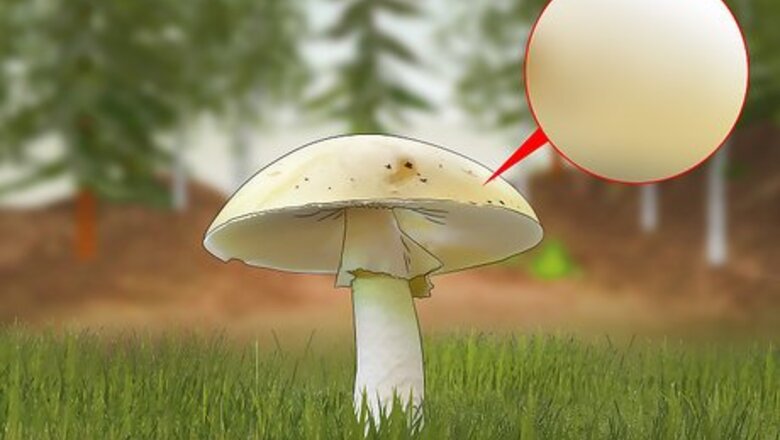
views
- Look for sticky, yellow or green tinted caps that are up to 6 in (15 cm) wide and crowded, white gills underneath.
- Examine the stalk size. Death cap stalks are usually 5–18 cm (2.0–7.1 in) tall and 1–2.5 cm (0.39–0.98 in) thick.
- Check for a distinct, ammonia-like odor, and look for death caps around the bases of oaks or pine trees.
- Death caps originated in Europe, but have become invasive species in many places like the Mediterranean, Africa, Australia, West Asia, and parts of the US.
Inspecting the Cap
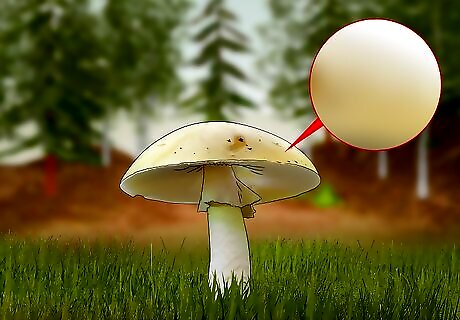
Look for a green or yellow tint on the top of the mushroom’s white cap. The color of a death cap mushroom can vary based on its growing conditions. In general, though, the caps are off-white and can have tints of olive green, pale green, or yellow. Older mushroom caps can become almost brown.Note: The Amanita caesarea mushroom, which is perfectly safe to eat (although sometimes mistaken for a death cap), has a bright orange-colored cap. The caps of mature mushrooms also often have 1 or 2 large cracks running across them. Death caps often have 1 or more patches of thin, white, veil-like tissue.
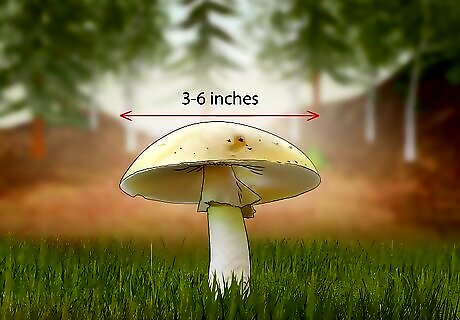
Look for a flat cap with a diameter between 3–6 in (7.6–15.2 cm). Mature death caps are wide and nearly flat on top. Use a ruler or a tape measure to find the distance from one edge of the cap to the opposite edge to check the diameter. It’s safe to touch the mushroom directly without wearing gloves. The mushroom’s toxins can only harm you if you ingest them (but we recommend gloves, anyway). Mature paddy straw mushrooms have caps that are similar to death caps in size and shape, which can make it hard to differentiate them.
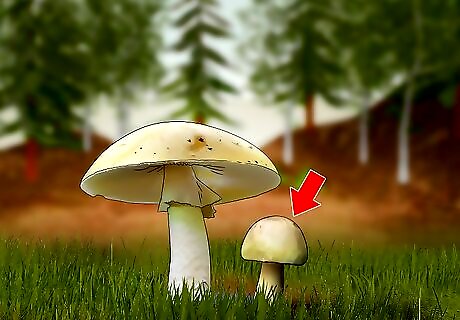
Inspect immature death cap mushrooms for a very rounded cap. If the diameter of the cap is less than 3–6 in (7.6–15.2 cm), examine the shape. Young death caps have an almost spherical, bowl-shaped cap. They may be so rounded that they curve around and nearly touch the stalk.Note: Young and mature death caps are equally toxic. The amount of toxins in 1 mushroom is enough to kill an adult, and a few bites would be enough to kill a child or pet. A newly sprouted death cap may look like a dumpling with a white, smooth, faintly furry surface. Edible puffball mushrooms can sometimes look like death caps, making it tricky to identify edible mushrooms as opposed to poisonous ones. To check, slice open the mushroom. If it has a solid inside with no gills, it’s an edible puffball.
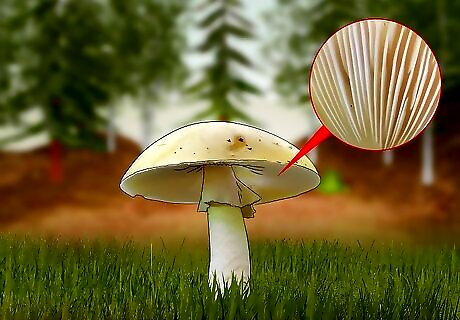
Check for crowded white gills underneath the cap. The death cap mushroom displays thin white gills on the underside of the cap. Flip the mushroom’s cap upside down (you may need to crouch down close to the ground) and take a look on the underside for gills. These fine gills are densely crowded together near the outer edges of the mushroom’s cap and are very finely attached to the stem. Other amanitas mushrooms also have crowded gills beneath their caps, so the presence of gills alone isn’t a surefire indicator that the mushroom is a death cap. Use this as a clue, but be sure to rely on the other tells, as well. The paddy straw mushroom’s gills are pinkish brown, as opposed to the death cap’s white gills. Other mushrooms, such as those of the genus Agaricus, also have pink gills (although they turn brown as the mushrooms mature).
Inspecting the Stalk
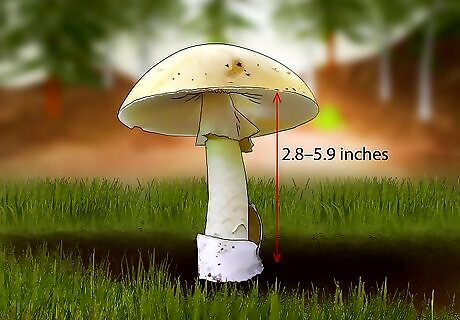
Look for a whitish stalk that’s about 5–18 cm (2.0–7.1 in) tall. One of the death cap’s characteristics is its tall, white or yellowish stalk. This stalk is about 1–2.5 cm (0.39–0.98 in) thick, and elevates the cap above the forest floor. Either gently dig the mushroom out of the soil or brush away the soil around its base. Then, use a ruler or measuring tape to measure the stalk’s height, from the soil up to the bottom of the cap. The stalk is typically a shade lighter in color than the cap itself. Death caps’ stalks are often also covered with a light layer of fine hairs. The edible Amanita caesarea mushroom has a yellow stem which is usually 2–3 inches (5.1–7.6 cm) shorter than that of the death cap mushroom.
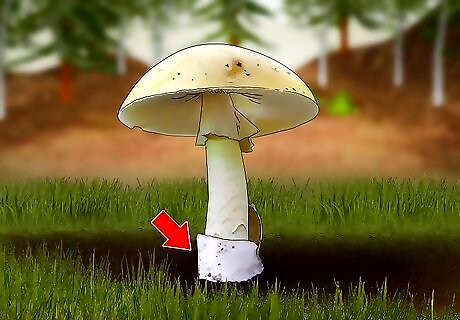
Check out the base of the mushroom for a white, cup-like structure. The bulbous structure at bottom of the stalk is known as a “volva,” and it’s a remnant of the tissue that protected the mushroom’s gills while it grew. If the volva isn’t already exposed, use a trowel to dig down a bit into the soil or uproot the plant to find the lower part of the mushroom’s stalk. The volva of a death cap mushroom can be fairly large, growing to an inch or so in diameter. The volva may break away or fall apart over time, so if it isn't present, the mushroom could still be an amanita mushroom. Paddy straw mushrooms also have a volva of roughly the same size, so finding a volva isn’t enough to guarantee that a mushroom is a death cap.
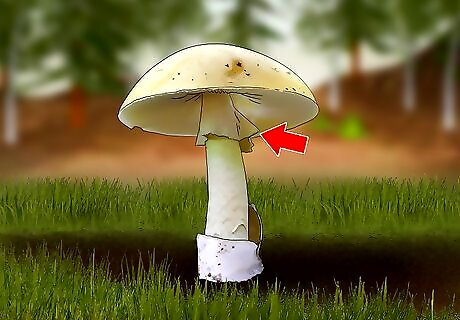
Inspect the top of the stalk for a loose, skirt-like membrane. The “skirt” of the death cap mushroom is a thin membrane that circles the stalk just beneath the mushroom’s cap. Tilt the mushroom to the side and take a look just beneath the base of the cap. This membrane will be white in color, and will appear to loosely cling to the top 2–3 inches (5.1–7.6 cm) of the stalk. If you dig up and handle the death cap mushroom, you may inadvertently destroy this delicate skirt membrane. If you happen across a very young death cap mushroom, you’ll notice that this skirt goes from the stem to the edges of the cap, covering the mushroom’s gills.
Other Death Cap Characteristics
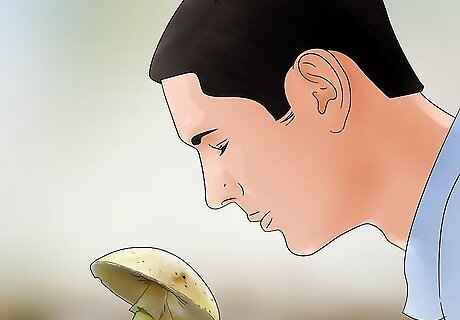
Smell the mushroom’s flesh for an ammonia-like odor. Hold the mushroom about 3 inches (7.6 cm) away from your nose and take a sniff. A death cap mushroom smells slightly like ammonia or other chemical household cleaners, giving it a unique scent in the mushroom world. Use this test if you can’t tell from its physical appearance whether the mushroom is a death cap or other variety. While you’re smelling the mushroom, do not taste or ingest any. While you won’t die if a tiny bit enters your mouth, you could still become seriously ill. Most other types of mushrooms do not have a potent odor.
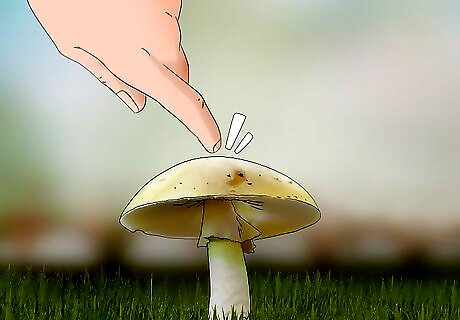
Tap the cap with 1 or 2 fingers to see if it’s sticky. Make sure you tap lightly enough that you won’t break off part of the mushroom or knock it out of the ground. The caps of death cap mushrooms are often slightly sticky and may leave a small amount of adhesive residue behind on your fingers when you tap lightly on them. The cap might also feel slightly slippery to the touch. Tip: The death cap is perfectly safe to touch, as its toxin is only dangerous if ingested. If you’re uncomfortable touching the poison mushroom, though, try wearing a pair of gloves. Make sure to wash your hands thoroughly after you’ve touched the death cap. If you eat before washing your hands, you may become ill from the mushroom’s toxins.
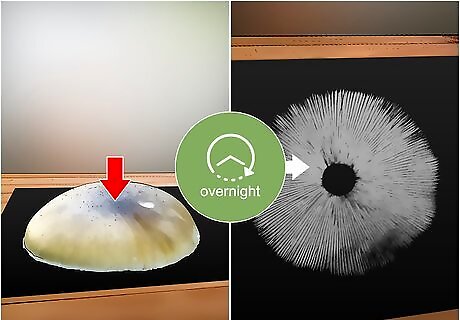
Collect a spore print and look for white spores left behind. To collect a spore print from a death cap mushroom, place the mushroom cap on a piece of dark-colored paper with the gills facing downward. Let the mushroom sit in this position overnight. The next morning, lift up the mushroom cap and look for a white spore print on the sheet of paper. A death cap mushroom will leave a white spore print. If you’re dealing with the harmless paddy straw mushroom instead of a death cap, you’ll see a pink spore print on the paper. Make sure that no kids or pets can get into the room where you’re collecting the spore print while the death cap is resting on paper overnight.
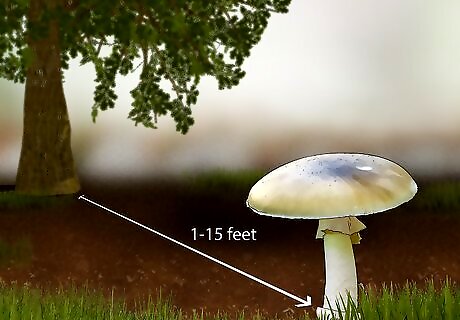
Find death caps within 1–15 feet (0.30–4.57 m) of tree trunks. In some cases, you’ll have to get quite close to the base of the tree to locate death cap mushrooms. Like many other mushroom species (e.g., the paddy straw), death caps are most frequently found in forested areas, since they exist in a symbiotic relationship with the trees’ roots. You can find them sprouting directly out of the roots in some cases. Death caps can commonly be found beneath oak and pine trees as well as some beech, birch, chestnut, and eucalyptus trees. That said, you may find death cap mushrooms in some grassy areas, although this is relatively uncommon.
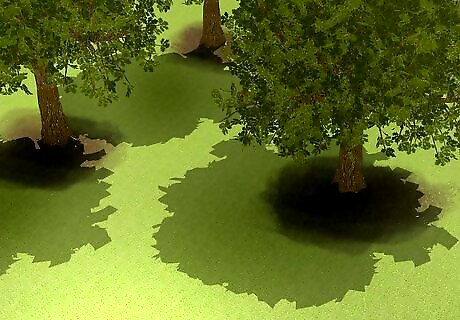
Expect to see death caps in oak-filled temperate forests. The mushrooms originated in Europe, and are still found in many temperate European forests. They have spread across parts of the globe, though, and can thrive in temperate forests, especially those where oak trees are found in abundance. Death caps frequently crop up in North Africa, although don’t often appear in other parts of the continent. Note: In the U.S., death caps have been found among oaks in coastal areas, such as New Jersey, Oregon, and the San Francisco Bay area of California. Recently, they’ve been found in the Rocky Mountain region, as well. Death caps also thrive in forested regions of southern Australia, specifically around the cities of Adelaide and Canberra.
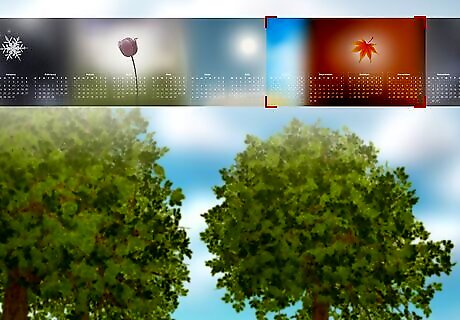
Look for death cap mushrooms during late summer and fall. In temperate latitudes, the death cap mushroom is found during late summer to late fall. During this time of the year, temperatures are favorable to the growth of many types of mushrooms, including the death cap. It’s very unlikely that you’d find death caps in the wild during winter or spring. In North America and Europe, late summer through late fall would be from late August to late November. In Australia and South America, this would be from late February to late May.














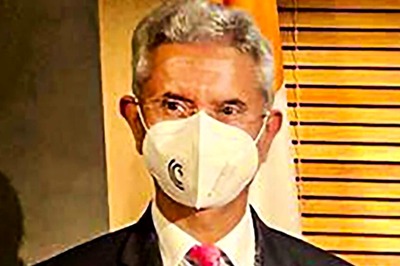


Comments
0 comment